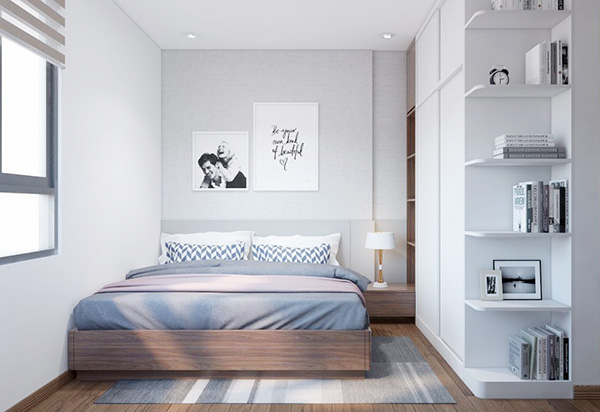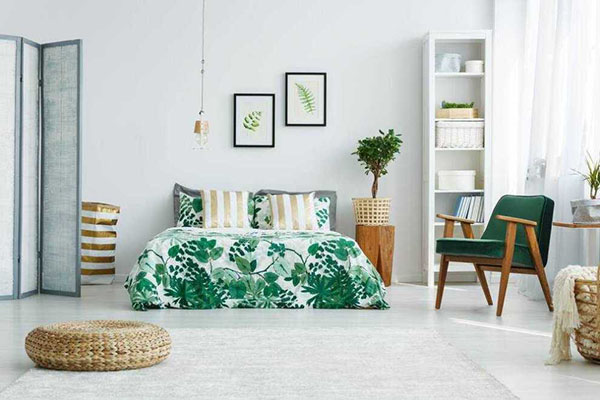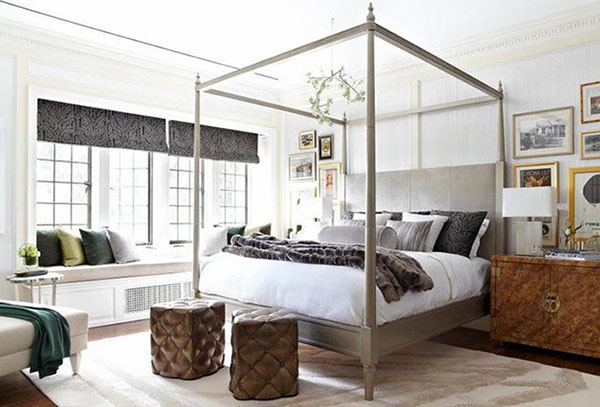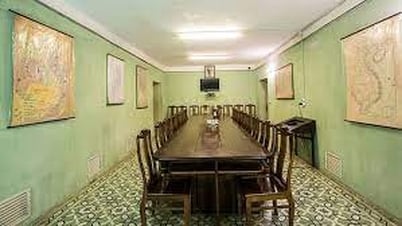Determine the minimum path
To determine whether a large bed will actually fit in the room, experts recommend making sure there is at least about 60 cm of space around the bed. This is the minimum for comfortable walking.

To move comfortably with a large bed in a small room, not only do you need minimal space, but you also need to pay attention to the type of bed. You should choose a bed without legs to create a spacious feeling and avoid injuries when moving in a limited space.
Choose bed height
People often think that a low bed is the best choice for a small bedroom. However, expert Tami Ramsay of US interior design company Cloth & Kind believes that it is much more important to have a bed that is comfortable for the user.
It may not be the most flattering proportion to the ceiling height of the room, but we prioritize comfort when choosing beds, says Tami Ramsay. Her projects all feature beds that are 24 to 28 inches high. Also, consider the symmetry of the bed height with the headboard.
Make use of the wall
One space-saving tip that designers recommend over and over again is to opt for wall-mounted nightstands. Instead of a standard bedside table, opt for a wall-mounted nightstand. Instead of a table lamp, install a wall-mounted light.

New York-based interior designer Matthew Kowles recommends installing custom shelves like bookshelves next to the bed. When you have a tight space, a bed with bookshelves next to it feels like a ship's cabin, he describes.
Avoid monochrome
Suzanne Tucker, co-founder of San Francisco interior design firm Tucker & Marks, says there needs to be at least some contrast between the bed and the rest of the room. Contrast can be a subtle mix of tones or patterns, she says.
Don’t be afraid to use pattern in a small room with a large bed. In a recent project, Tami Ramsay of Cloth & Kind used bold patterns on the headboard, curtains, side chairs, and pillowcases. While it may seem counterintuitive to use so much pattern in a small space, the combination of four different patterns draws attention away from the relatively large size of the bed, according to the designer.
Choose light
Not all wall sconces create the same effect in a tight space. Installing the wrong fixture in the wrong spot can be a headache. Ramsay says that in tight spaces, the ideal is to use portable lighting that can be easily moved out of the way rather than having multiple fixtures. Also, choose fixtures that have adjustable intensity.
Use a mirror
Mirrors are a classic way to make a room look larger. When you're putting a large bed in a small space, experts suggest adding smaller mirrors in other places besides the usual mirror on a dressing table. For example, Kowles hangs a pair of mirrors on her nightstand to create another vanity point.
Don't skimp on bedding
When you walk into a small room, the bedding is the most dominant thing in the space, says Cindy Rinfret, founder of Connecticut-based design firm Rinfret. So make sure you love your bedding.
Blackout curtains and four poster bed are fine

You might think that a four-poster bed or large decorative curtains would be too bulky in a small room. But Tucker designs them often, saying that "the feeling of a room within a room works very well in small spaces" because it creates coziness.
If you want to add curtains around the bed, her advice is to make sure they are long enough to hug the floor.
Source


























![[Photo] Prime Minister Pham Minh Chinh receives Australian Foreign Minister Penny Wong](https://vphoto.vietnam.vn/thumb/1200x675/vietnam/resource/IMAGE/2025/8/20/f5d413a946444bd2be288d6b700afc33)




![[Photo] Politburo works with Standing Committees of Lang Son and Bac Ninh Provincial Party Committees](https://vphoto.vietnam.vn/thumb/1200x675/vietnam/resource/IMAGE/2025/8/20/0666629afb39421d8e1bd8922a0537e6)








































































Comment (0)